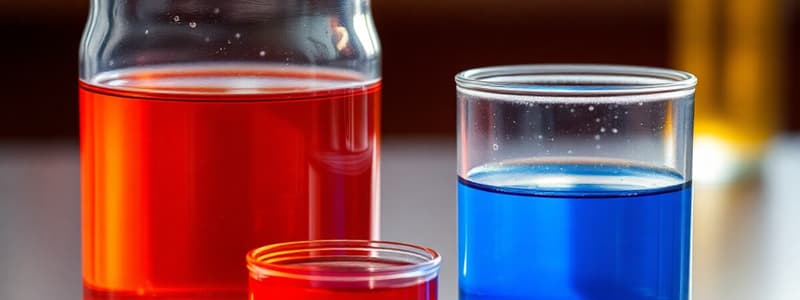Podcast
Questions and Answers
Substances that taste sour contain ______.
Substances that taste sour contain ______.
acids
The chemical nature of substances that contain acids is described as ______.
The chemical nature of substances that contain acids is described as ______.
acidic
The word 'acid' comes from the Latin word '______' which means sour.
The word 'acid' comes from the Latin word '______' which means sour.
acere
Substances with a bitter taste and soapy feel are generally known as ______.
Substances with a bitter taste and soapy feel are generally known as ______.
The nature of substances that are bases is said to be ______.
The nature of substances that are bases is said to be ______.
Substances used to test whether a substance is acidic or basic are known as ______.
Substances used to test whether a substance is acidic or basic are known as ______.
[Blank] is a commonly used natural indicator, extracted from lichens.
[Blank] is a commonly used natural indicator, extracted from lichens.
Litmus has a ______ (purple) colour in distilled water
Litmus has a ______ (purple) colour in distilled water
When added to an acidic solution, litmus turns ______, and when added to a basic solution, it turns blue.
When added to an acidic solution, litmus turns ______, and when added to a basic solution, it turns blue.
Solutions that do not change the colour of either red or blue litmus are known as ______ solutions.
Solutions that do not change the colour of either red or blue litmus are known as ______ solutions.
Acid rain is caused by the dissolution of gases like sulphur dioxide and nitrogen dioxide which form carbonic acid, ______ acid and nitric acid.
Acid rain is caused by the dissolution of gases like sulphur dioxide and nitrogen dioxide which form carbonic acid, ______ acid and nitric acid.
Acids and bases are ______ in nature, irritating and harmful to the touch.
Acids and bases are ______ in nature, irritating and harmful to the touch.
The reaction between an acid and a base is known as ______.
The reaction between an acid and a base is known as ______.
In a neutralisation reaction, ______ is always produced, or evolved.
In a neutralisation reaction, ______ is always produced, or evolved.
To relieve indigestion, we take an ______ such as milk of magnesia, which contains magnesium hydroxide.
To relieve indigestion, we take an ______ such as milk of magnesia, which contains magnesium hydroxide.
Flashcards
Acids
Acids
Substances that taste sour and contain acids. The chemical nature of these substances is acidic.
Bases
Bases
Substances that taste bitter and feel soapy. The nature of these substances is called basic.
Indicators
Indicators
Special substances used to test whether a substance is acidic or basic by changing color.
Litmus
Litmus
Signup and view all the flashcards
Turmeric as Indicator
Turmeric as Indicator
Signup and view all the flashcards
Phenolphthalein
Phenolphthalein
Signup and view all the flashcards
Neutralisation
Neutralisation
Signup and view all the flashcards
Salt
Salt
Signup and view all the flashcards
Acid Rain
Acid Rain
Signup and view all the flashcards
Relieving Indigestion
Relieving Indigestion
Signup and view all the flashcards
Neutralising an ant bite
Neutralising an ant bite
Signup and view all the flashcards
Treating Acidic Soil
Treating Acidic Soil
Signup and view all the flashcards
Neutralizing Factory Wastes
Neutralizing Factory Wastes
Signup and view all the flashcards
Neutralisation reaction
Neutralisation reaction
Signup and view all the flashcards
Study Notes
- Many daily substances like lemon, tamarind, salt, sugar, and vinegar have different tastes
Acids and Bases
- Acids taste sour, giving substances like curd, lemon juice, orange juice, and vinegar their tartness
- The word "acid" originates from the Latin word "acere," meaning sour
- Bases generally taste bitter and feel soapy
- Indicators are substances used to test if a substance is acidic or basic
- Indicators change color when added to acidic or basic solutions
- Examples of naturally occurring indicators include turmeric, litmus, and China rose petals (Gudhal)
Natural Indicators Around Us - Litmus
- Litmus is a common natural indicator extracted from lichens
- Litmus has a mauve (purple) color in distilled water
- Litmus turns red in acidic solutions and blue in basic solutions
- Litmus is available as a solution or as strips of paper called litmus paper
Activity 4.1
- Mix lemon juice and water in a plastic cup
- Put a drop of the lemon juice solution on a strip of red litmus paper
- Note any color change
- Repeat the experiment with blue litmus paper and other substances (tap water, detergent, soap, shampoo, salt, sugar, vinegar, baking and washing soda , milk of magnesia, lime water)
Neutral Solutions
- Solutions that do not change the color of either red or blue litmus paper are of neutral solutions
- Neutral substances are neither acidic nor basic
Turmeric as Indicator
- Turmeric can be used as a natural indicator
- Create turmeric paper by applying a turmeric paste on blotting/filter paper and let it dry
- Apply a drop of soap solution on the turmeric paper
- Turmeric paper turns red in soap solution
China Rose as Indicator
- Collect China rose (Gudhal) petals
- Immerse it in mixture of warm water until water it colored
- Use the colored warm water as a indicator
- China rose indicator turns acidic solutions to dark pink (magenta) and basic solutions to green
Table 4.4
- Shampoo (dilute solution), lemon juice soda water, sodium hydrogencarbonate solution, vinegar, sugar and common salt solution can be tested as shown in the the table
- Keep the mixture for some time till water becomes colored.
- Use the coloured water as an indicator and add five drops of the indicator to each of the solutions
Table 4.5
- Dilute hydrochloric acid can be tested as shown in the table
- Record the effect on litmus paper, on tumeric papaer and China rose solution for this acid
Acid Rain
- Acid rain contains excessive acids and can damage buildings, historical monuments, plants, and animals
- Acid rain forms when carbon dioxide, sulfur dioxide, and nitrogen dioxide (pollutants) dissolve in rain, producing carbonic acid, sulfuric acid, and nitric acid
Neutralisation
- Acids turn blue litmus red
- Bases turn red litmus blue
- Neutralization occurs when an acid and base react, canceling each other's effects
- Mixing an acid solution with a basic solution neutralizes the effect of each of the solutions
- In neutralization, heat is produced, raising the temperature of the reaction mixture
- A new substance, called salt, is formed during neutralization
- Salt may be acidic, basic, or neutral
- Neutralisation salt and water are produced with the evolution of heat:
- Acid + Base -> Salt + Water (+ Heat)
- Example: Hydrochloric acid (HCl) + Sodium hydroxide (NaOH) -> Sodium chloride (NaCl) + Water (H2O)
Neutralisation in Everyday Life - Indigestion
- The stomach contains hydrochloric acid to aid digestion
- Too much acid leads to indigestion, which can be relieved by taking an antacid like milk of magnesia (magnesium hydroxide), which neutralizes the excessive acid
Ant Bite
- Ants inject formic acid into the skin when they bite
- The acid's effect can be neutralized by rubbing moist baking soda (sodium hydrogencarbonate) or calamine solution (zinc carbonate) on the affected area
Soil Treatment
- Excessive use of chemical fertilizers makes the soil acidic, hindering plant growth
- Acidic soil is treated with bases like quick lime (calcium oxide) or slaked lime (calcium hydroxide)
- Basic soil is treated with organic matter (compost), which releases acids that neutralize the soil
Factory Wastes
- Many factory wastes contain acids
- These wastes must be neutralized by adding basic substances before being released into water bodies to prevent harm to aquatic life
Keywords
- Main terms to remember are Acid, Acidic, Base Basic, Indicator, Neutral and Neutralisation
Studying That Suits You
Use AI to generate personalized quizzes and flashcards to suit your learning preferences.




